Discover 11 hidden attractions, cool sights, and unusual things to do in Mackinac Island (United States). Don't miss out on these must-see attractions: Fort Mackinac, Skull Cave, and Richard and Jane Manoogian Mackinac Art Museum. Also, be sure to include Mackinac Island State Park in your itinerary.
Below, you can find the list of the most amazing places you should visit in Mackinac Island (Michigan).
Table of Contents
Fort Mackinac
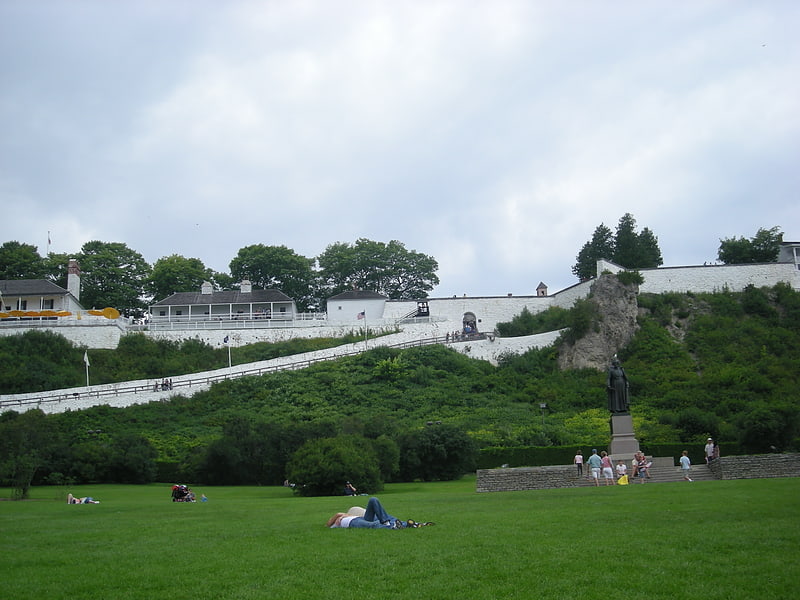
Museum. Fort Mackinac is a former British and American military outpost garrisoned from the late 18th century to the late 19th century in the city of Mackinac Island, Michigan, on Mackinac Island. The British built the fort during the American Revolutionary War to control the strategic Straits of Mackinac between Lake Michigan and Lake Huron, and by extension the fur trade on the Great Lakes. The British did not relinquish the fort until thirteen years after the end of the American Revolutionary War. Fort Mackinac later became the scene of two strategic battles for control of the Great Lakes during the War of 1812. During most of the 19th century, it served as an outpost of the United States Army. Closed in 1895, the fort has been adapted as a museum on the grounds of Mackinac Island State Park.[1]
Address: 7029 Huron Rd, 49757 Mackinac Island
Skull Cave
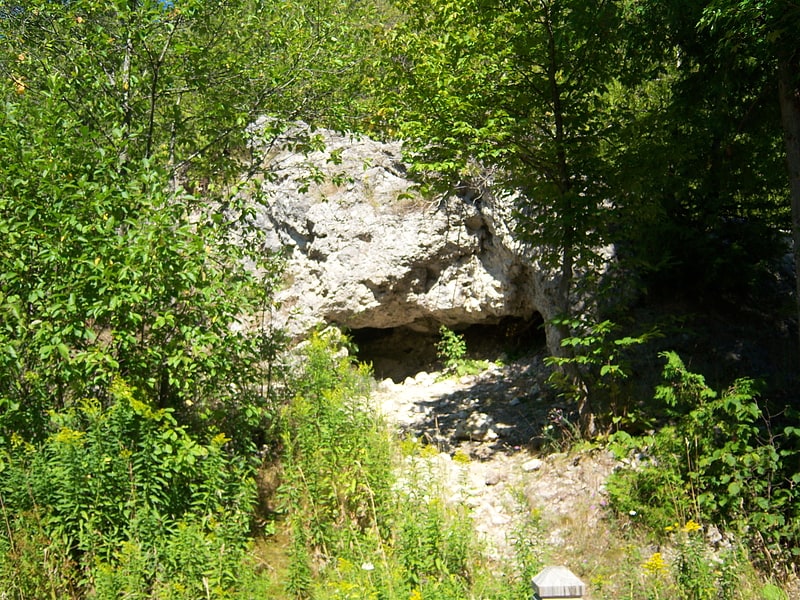
Historical place in Mackinac Island, Michigan. Skull Cave is a small and shallow cave on the central heights of Mackinac Island in Michigan, United States. The cave was carved during the Algonquin post-glacial period by the waters of Lake Algonquin, a swollen meltwater ancestor of today's Lake Huron.
Skull Cave is primarily of interest for its historical associations. It is believed to have been used as an inhumation site by Native Americans of the Straits of Mackinac area in the 18th century.
While in active use as a site for human remains, the cave was also used as a refuge in 1763 by fur trader Alexander Henry, a survivor of the capture of Fort Michilimackinac by Native Americans during Pontiac's War. In his "Memoirs," Henry recalled a night spent as a refugee in the bone-strewn cavern.
Henry recalled his ordeal as follows:
On going into the cave, of which the entrance was nearly ten feet wide, I found the further end to be rounded in its shape, like that of an oven, but with a further aperture, too small, however, to be explored. After thus looking around me, I broke small branches from the trees and spread them for a bed, then wrapped myself in my blanket and slept till day-break. On awaking, I felt myself incommoded by some object upon which I lay, and, removing it, found it to be a bone. This I supposed to be that of a deer, or some other animal, and what might very naturally be looked for in the place in which I was; but when daylight visited my chamber I discovered, with some feelings of horror, that I was lying on nothing less than a heap of human bones and skulls, which covered the floor!
Skull Cave is contained within Mackinac Island State Park. It is located 0.4 miles (0.6 km) north of Fort Mackinac in the island's interior. It was designated as a Michigan Historic Site on January 12, 1959, and granted state historical marker #L0004.[2]
Richard and Jane Manoogian Mackinac Art Museum
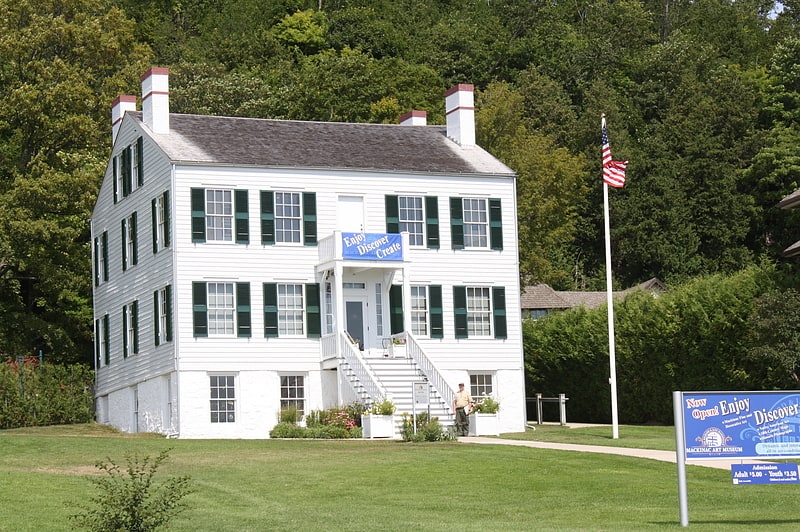
Art museum in Mackinac Island, Michigan. The Richard and Jane Manoogian Mackinac Art Museum is an art museum located in the historic Indian Dormitory building on Mackinac Island, Michigan. The museum's exhibits feature art inspired by Mackinac Island, including historic painting and maps, photographs from the mid-19th to the mid-20th century, Native American art and beaded garments, and contemporary art and photography from area artists.
The museum is one of many attractions in Mackinac Island State Park.[3]
Address: 7070 Main St, 49757 Mackinac Island
Mackinac Island State Park
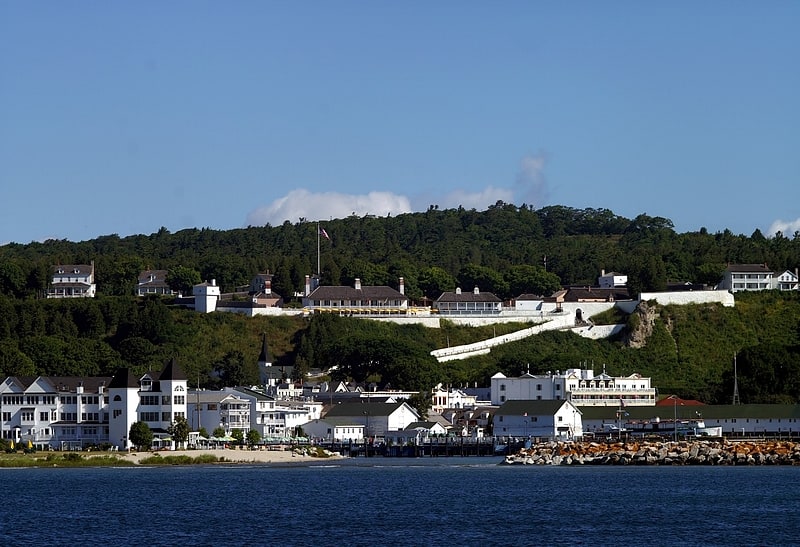
Island in Mackinac Island, Michigan. Mackinac Island State Park is a state park located on Mackinac Island in the U.S. state of Michigan. A Lake Huron island, it is near the Straits of Mackinac. The island park encompasses 1,800 acres, which is approximately 80% of the island's total area. The park is also within the boundaries of the city of Mackinac Island and has permanent residents within its boundaries. M-185 circles the perimeter of the park as the only motorless highway in the state due to the island's ban of automobiles. The park is governed by the Michigan Department of Natural Resources and the Mackinac Island State Park Commission. On July 15, 2009, the park celebrated its 20 millionth visitor.
The park was first established as Mackinac National Park in 1875, which was the second national park established in the United States after Yellowstone National Park. In 1895, it was transferred to state control and reorganized as Mackinac Island State Park, which was the first state park in Michigan. The park contains many important historical and geological features, such as Fort Mackinac, Fort Holmes, other historic buildings, historic sites, limestone caves, and other unique rock formations. The park also operates the Mackinac Island Airport. Many of these sites are formally operated by the Mackinac Island State Park Commission, which also operates two other parks around the Straits of Mackinac area: Colonial Michilimackinac and Historic Mill Creek Discovery Park.[4]
Marquette Park

Park in Mackinac Island, Michigan. Marquette Park is a landscaped park located on Mackinac Island in the U.S. state of Michigan. It is part of Mackinac Island State Park and stands on the edge of Mackinac Island's harbor on the Round Island Channel and just east of downtown Mackinac Island.[5]
Address: 7200 Huron St, 49757 Mackinac Island
Mission Church
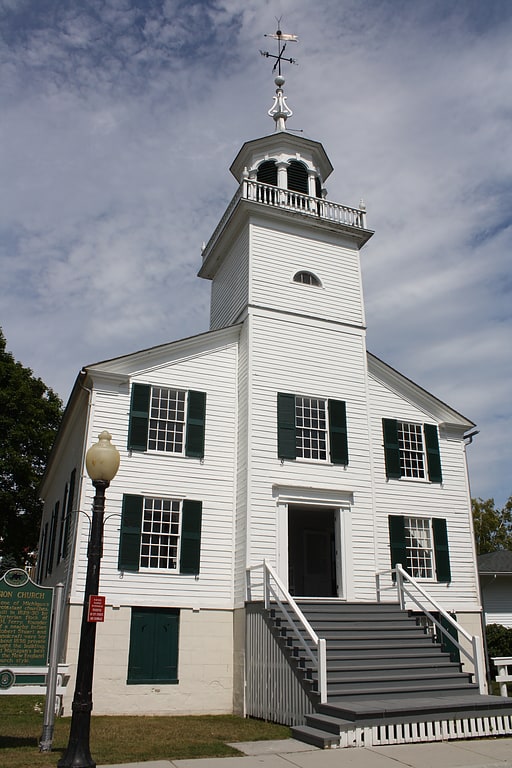
Congregational church in Mackinac Island, Michigan. The Mission Church is a historic Congregational church located at the corner of Huron and Tuscott Streets on Mackinac Island, Michigan, United States. Built in 1829, it was the oldest surviving church in the state of Michigan. In 1971, the Mission Church was listed on the National Register of Historic Places.
Sainte Anne Church (Mackinac Island) was built before this, as the island had a historic French and Metis population before Anglo-American settlement. Its original building was replaced by a new structure in 1874, which is still used.[6]
Address: 6670 Lake Shore Drive, 49757 Mackinac Island
Round Island Light
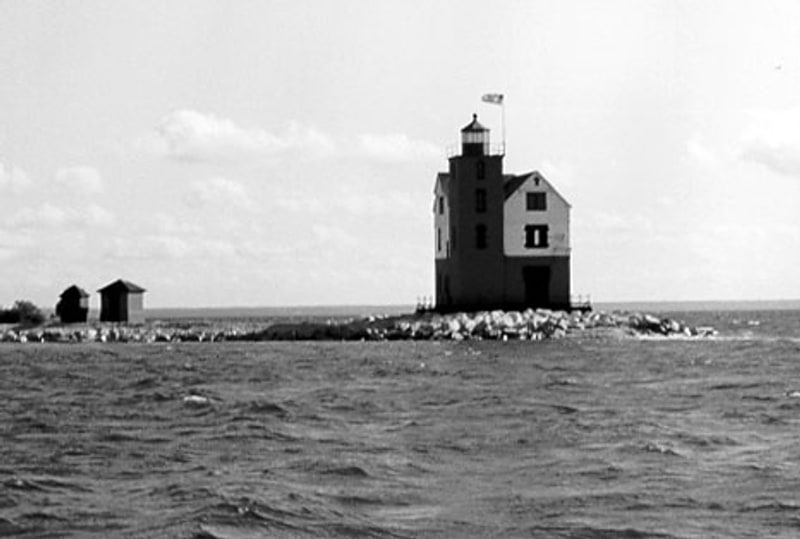
Lighthouse in Mackinac Island, Michigan. The Round Island Light, also known as the "Old Round Island Point Lighthouse" is a lighthouse located on the west shore of Round Island in the shipping lanes of the Straits of Mackinac, which connect Lake Michigan and Lake Huron. It was deemed necessary because the island is a significant hazard to navigation in the straits, and was seen as an effective complement to the other lights in the area. Because of its color scheme and form — red stone base and wood tower — it has been likened to an old-fashioned schoolhouse. Ferries regularly pass it on their way to Mackinac Island, and it is a recognizable icon of the upper Great Lakes.[7]
Round Island Passage Light
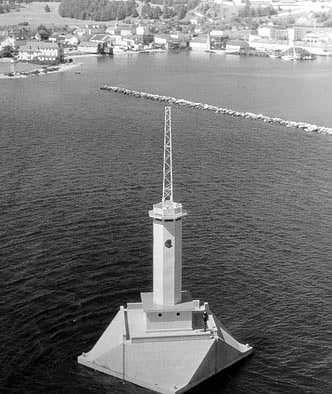
Lighthouse in Mackinac Island, Michigan. Round Island Passage Light is an automated, unmanned lighthouse located in the Round Island Channel in the Straits of Mackinac, Michigan. The channel is a branch of Lake Huron.[8]
Sainte Anne Church

Catholic church in Mackinac Island, Michigan. Sainte Anne Church, commonly called 'Ste. Anne Church' or 'Ste. Anne's Church', is a Roman Catholic church that serves the parish of Sainte Anne de Michilimackinac in Mackinac Island, Michigan. The Jesuit missionary Claude Dablon inaugurated the rites of the Catholic faith on Mackinac Island in 1670, but the earliest surviving parish records list sacraments performed starting in April 1695. After moving from Fort de Buade to Fort Michilimackinac about 1708 and from Fort Michilimackinac to Mackinac Island in 1781, the parish used a historic log church for decades. It constructed the current church complex starting in 1874 on a site donated by the former fur trader, Magdelaine Laframboise.[9]
Address: 6836 Huron Rd, 49757-5155 Mackinac Island
Fort Holmes
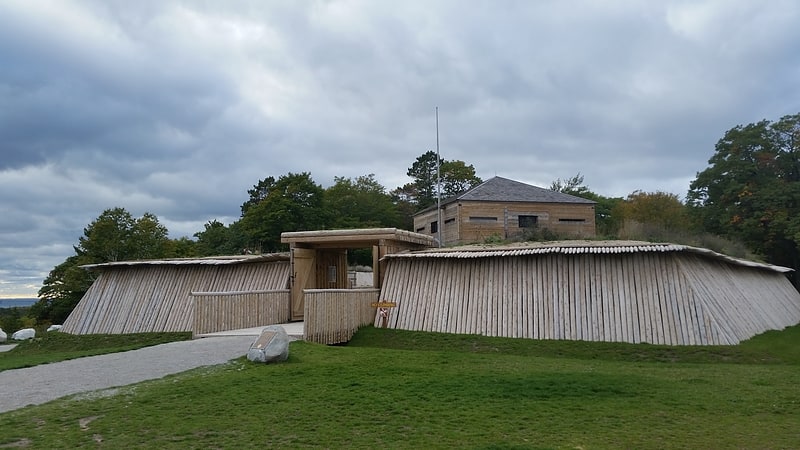
Historical landmark in Mackinac Island, Michigan. Fort Holmes is a fortified earthen redoubt located on the highest point of Mackinac Island. Originally built in 1814 by British forces during the War of 1812, the redoubt was improved by that army throughout the course of the war to help defend the adjacent Fort Mackinac from a possible attack by the U.S. Army.
The British named the redoubt Fort George and reinforced it with cannon, a blockhouse, and a magazine for gunpowder and other munitions. However, Fort Holmes never functioned as an independent military fortification. It was always a dependent outpost of nearby Fort Mackinac.
When United States armed forces reoccupied Mackinac Island in 1815 under the terms of the Treaty of Ghent, they took possession of Fort George. They surveyed and measured their prize, which they renamed Fort Holmes in honor of Major Andrew Holmes, a casualty in the 1814 Battle of Mackinac Island. However, the American army soon abandoned Fort Holmes. The earthworks and buildings of the former redoubt slowly eroded and disappeared over the course of more than a century.
In 1936, as part of its mission to provide employment through public works projects during the nationwide Great Depression, the Works Progress Administration used the original 1817 American survey to rebuild Fort Holmes to its War of 1812 appearance. As of 1984, however, most of the reconstructed buildings of Fort Holmes had again disappeared, except for the redoubt's earthen walls.
In 2015 the Mackinac Island State Park completed a second reconstruction of Fort Holmes that resumes the appearance that the redoubt had in 1817. The blockhouse includes interpretive panels inside, and is open in the summer. Many visitors come to the fort site for a view of the Straits of Mackinac, much of which is visible from this lookout point approximately 320 feet above the surface of Lake Huron and 890 feet above sea level. The redoubt and blockhouse can be rented for special occasions.[10]
Address: 2234 Fort Holmes Rd, 49757 Mackinac Island
Arch Rock
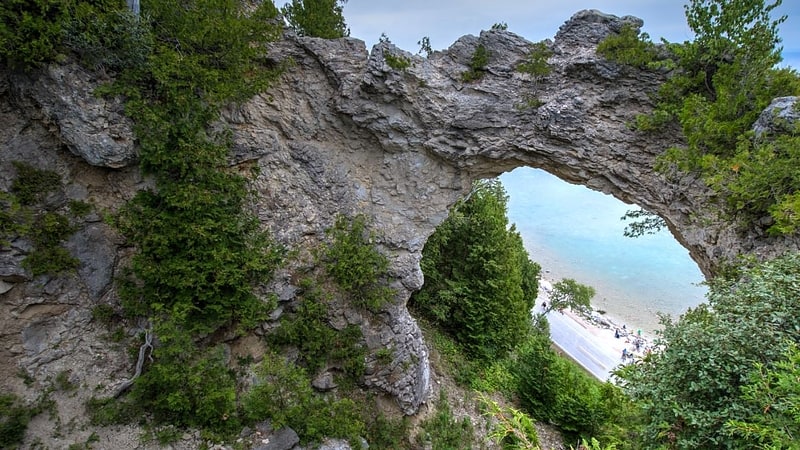
Geological formation in Michigan. Arch Rock is a geologic formation on Mackinac Island in Michigan. It is a natural limestone arch formed during the Nipissing post-glacial period, a period of high Lake Huron levels following the end of the Wisconsin glaciation. To this day Arch Rock stands on the Lake Huron shoreline 146 feet above the water.
Limestone breccia is not an ideal material for natural bridges, and this type of formation is quite rare in the North American Great Lakes region. The Native Americans saw Arch Rock as a place of numinous power, and told many stories and legends about it.
Euro-Americans did not share many of the taboos of their Native predecessors, and treated Arch Rock as a curiosity to be admired. One early chronicler was Alexis de Tocqueville who wrote of the "Giant's Arch" "of extraordinary shape" during his visit in August, 1831.
Its presence was a major element in the decisions to create Mackinac National Park in 1875 and its successor, Mackinac Island State Park, in 1895. Arch Rock has been a part of the State Park ever since. Today Arch Rock is a focus of Mackinac Island tourism, and is seen by many visitors to the Island. Several trails and paved roads, including the aptly named Arch Rock Road and Arch Rock Bicycle Trail, lead to the formation.[11]